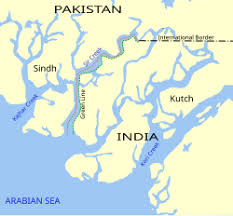Understanding the Sir Creek Dispute between India and Pakistan

Introduction
The Sir Creek is a tidal estuary that forms part of the international boundary between India and Pakistan in the Rann of Kutch region. The dispute over Sir Creek is not just a matter of territorial claim; it symbolizes the larger historical tensions between the two nations. With implications for maritime rights, fishing zones, and resource allocation in the Arabian Sea, resolving this issue is crucial for stability in South Asia.
The Geographic and Historical Context
Sir Creek runs along the border of Gujarat in India and Sindh in Pakistan, stretching approximately 96 kilometers (60 miles). The creek’s importance lies in its strategic location and potential to grant each country access to the Arabian Sea. This conflict dates back to the time of independence in 1947 when the ambiguous interpretation of the Radcliffe Award, which demarcated borders, left the area contentious. Both nations have since laid claim to the creek, with differing interpretations of the boundary lines.
Recent Developments
As of late 2023, low-level talks have resumed between Indian and Pakistani officials to address the Sir Creek dispute. Earlier in the year, the two countries participated in diplomatic discussions, emphasizing the necessity of resolving outstanding issues, including Sir Creek. However, significant progress remains elusive as both sides remain entrenched in their positions. The maritime boundaries of this area could potentially unlock lucrative fishing grounds and further development opportunities, escalating the stakes involved.
Significance of the Dispute
The Sir Creek issue goes beyond mere geography. Its resolution could pave the way for improved bilateral trade and cooperation in various sectors, including fishing, security, and environmental conservation. An agreement over Sir Creek may serve as a confidence-building measure for both nations, which have historically faced security challenges along their borders.
Conclusion
The Sir Creek dispute symbolizes the broader India-Pakistan relationship marked by historical grievances and territorial conflicts. While recent talks indicate a willingness to engage in dialogue, the path forward remains precarious. Continued negotiations could have important ramifications for not just the local populations reliant on the region’s resources but also for broader regional security. Addressing the complexities of such disputes is critical for the future of South Asian stability, underscoring the necessity for persistent dialogue and collaboration.









